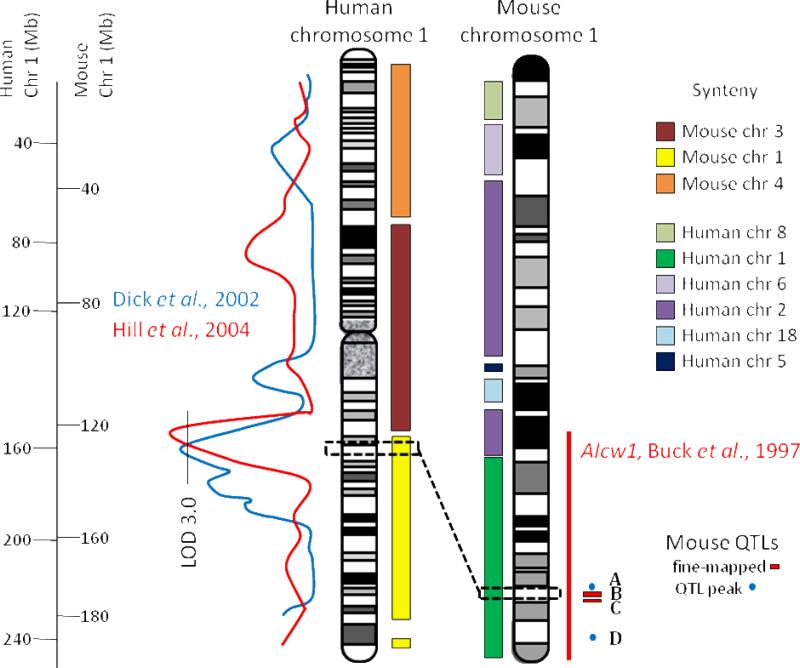Figure 2.
Synteny between human chromosome 1 and mouse chromosome 1 is illustrated with the colored bars. Human chromosome 1 shares primary conserved regions with mouse chromosomes 4, 3, and 1. Mouse chromosome 1 shares regions syntenic with human chromosomes 8, 6, 2, 5, 18, and 1. For both mouse and human there are smaller syntenic regions that we are not able to illustrate in detail here. Lines depicting LOD score plots are adapted from published QTLs to illustrate human alcohol dependence QTLs (blue line from Dick et al., 2002; red line from Hill et al., 2004) shown to the left of human chromosome 1. The red line to the right of mouse chromosome 1 shows the original 1-LOD confidence interval for the alcohol withdrawal QTL (Alcw1, Buck et al., 1997). Fine-mapping has delineated two QTLs (B and C with 1.7 Mb and 0.44 Mb QTL intervals, respectively) within the starting QTL region . The more proximal QTL (B) affects ethanol withdrawal, but not pentobarbital or zolpidem withdrawal (Kozell et al., 2008), while the more distal QTL (C) affects ethanol, pentobarbital, and zolpidem withdrawal (Kozell et al., 2009). Both QTLs are syntenic to human chromosome 1q23.2-1q23.3. Additionally, two reciprocal, coincident QTLs for ethanol consumption and ethanol withdrawal are located within this region (Hitzemann et al., 2009); the positions of the peak LOD values are indicated because these QTLs are not yet fine-mapped (A and D). The dashed black boxes and line indicate the QTL intervals on mouse (A, B, and also C) and human based on the fine mapping of the mouse QTLs and synteny with human distal chromosome 1. The region of mouse chromosome 1 in the dashed black box is syntenic to the region of human chromosome 1 dashed black box, but in reverse orientation, so the most distal gene in mouse chromosome 1 region is the most proximal in human chromosome 1 region and vice versa. Additionally, the most distal mouse QTL peak (D) is syntenic to very distal human chromosome 1 and is not included in the synteny block shown. Comparison of the narrowed mouse QTL on chromosome 1 with the human QTL suggests that the human QTL can also be narrowed to the small region on chromosome 1.

